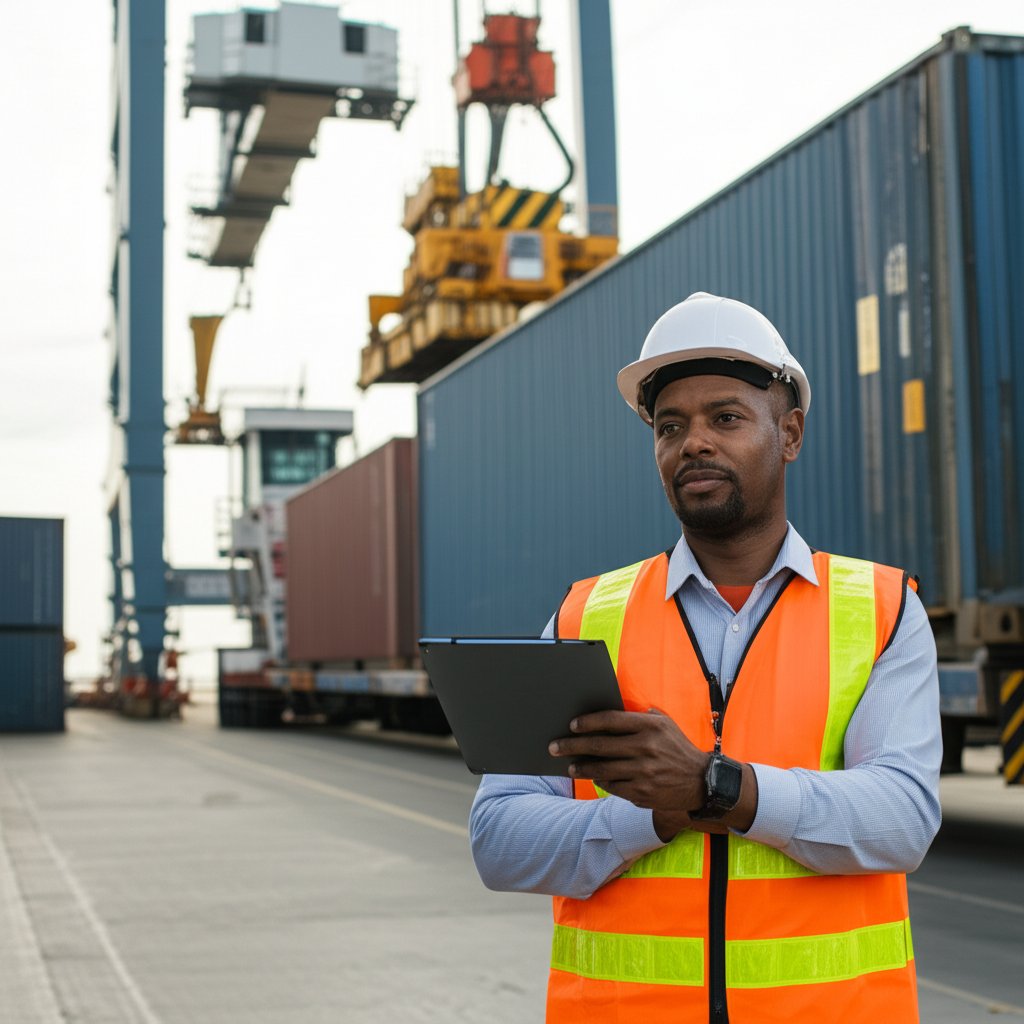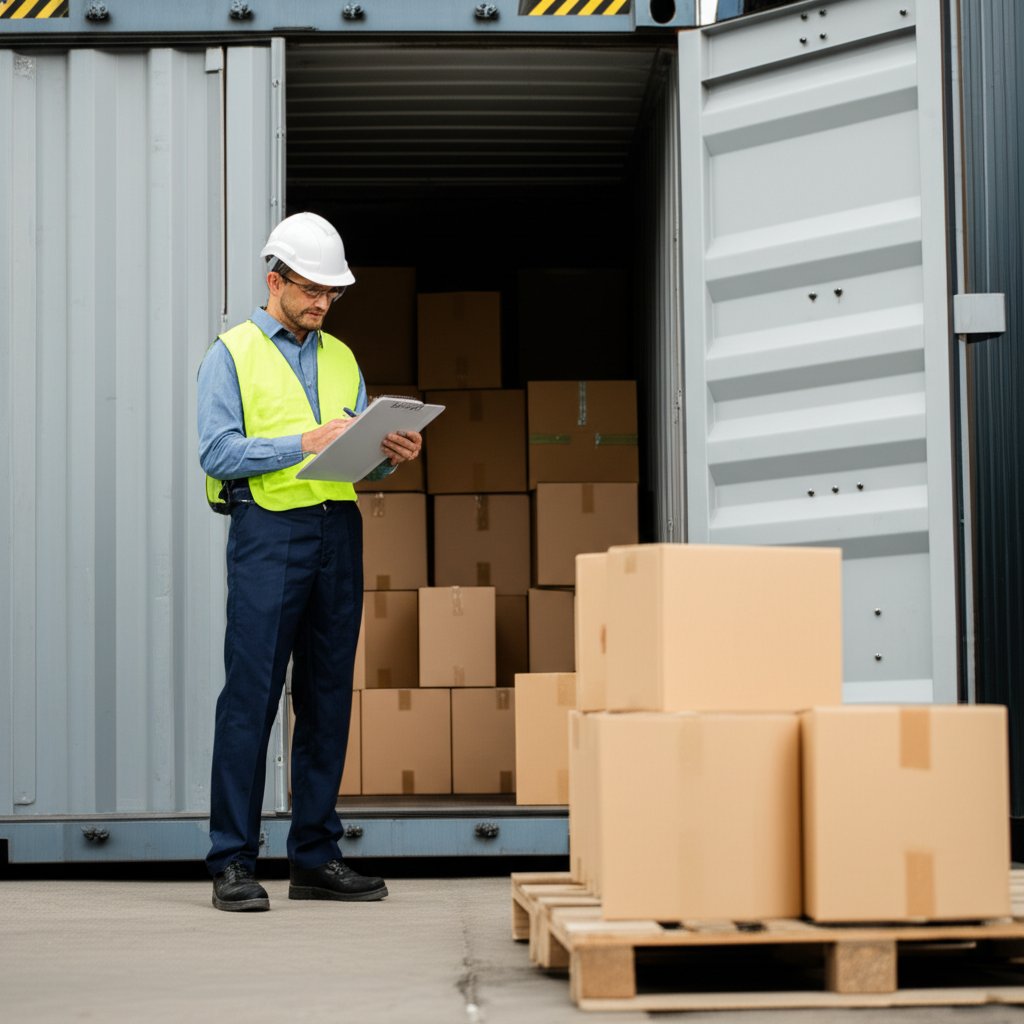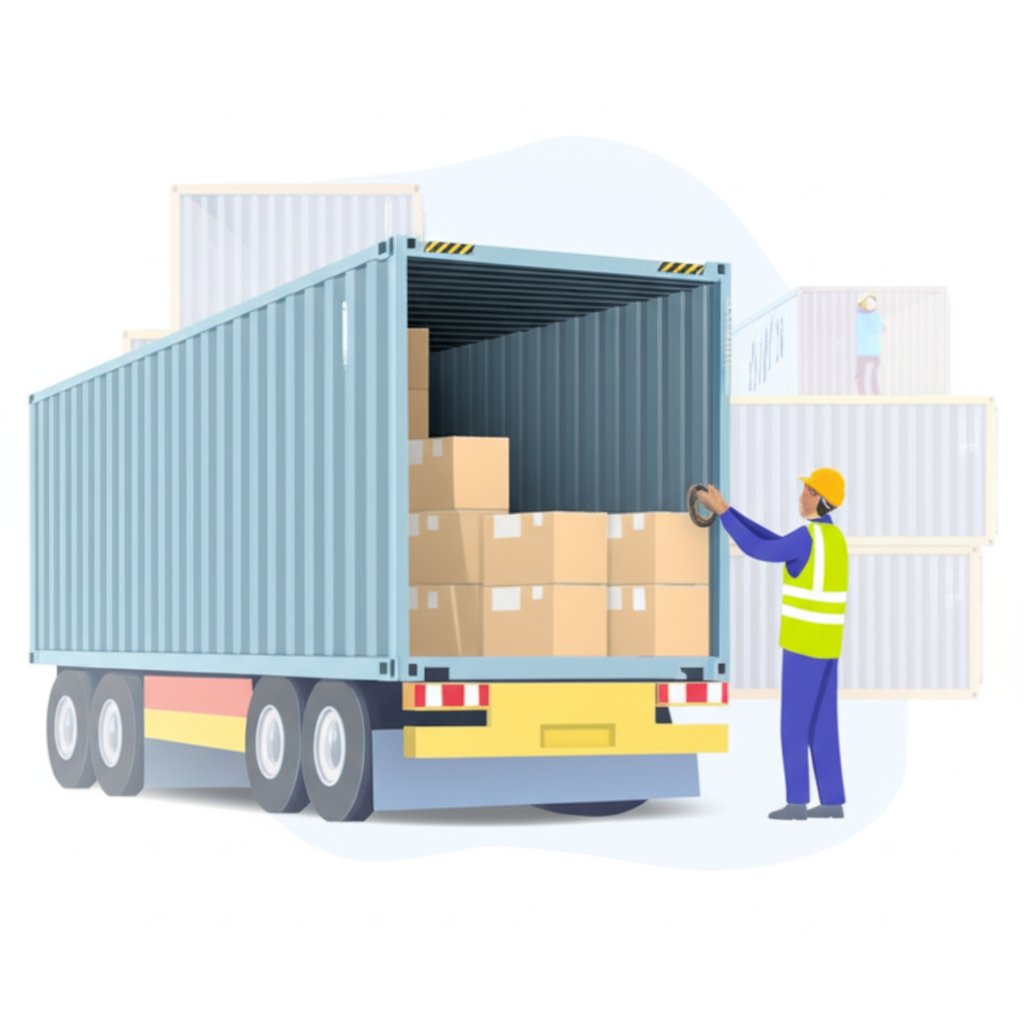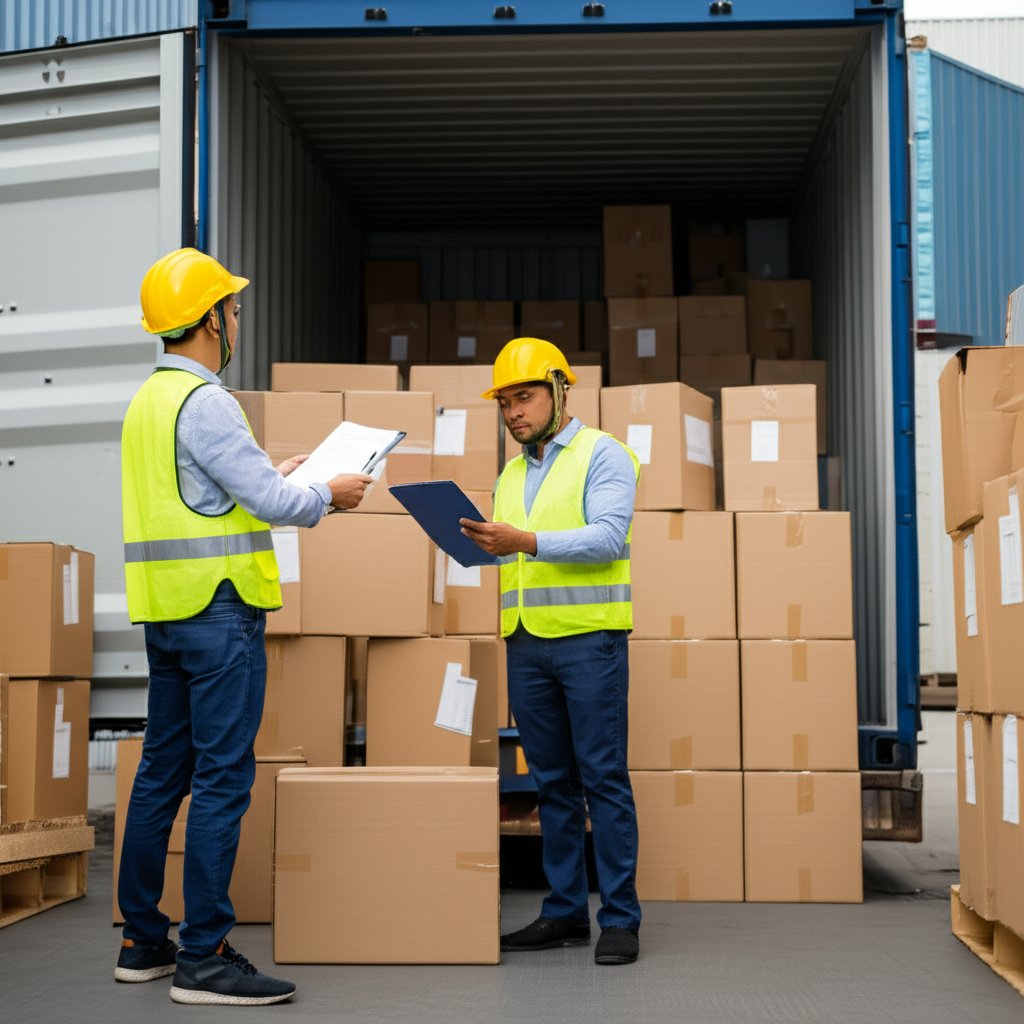
Introduction to Container Loading Supervision: Safeguarding Shipments in Global Trade
Ever wondered what really happens when your goods leave the factory and get packed into a shipping container? Imagine you’re an importer, waiting anxiously for your products to arrive from overseas. Will everything be there? Will items be damaged or missing? This is where container loading supervision steps in as a crucial safeguard in international trade.
Container loading supervision—sometimes called shipping container loading supervision—refers to the on-site monitoring of how goods are packed into shipping containers before they begin their journey across continents. Sounds complex? It doesn’t have to be. Think of it as having a trusted set of eyes at the factory, ensuring your cargo is handled with care and precision from the very start.
Why is this so important? In the world of global supply chains, even a small oversight during loading can lead to:
- Cargo damage due to poor stacking or unsecured goods
- Short shipments if quantities are miscounted or goods are left behind
- Mis-shipments where the wrong products end up in the container
- Costly delays caused by regulatory or documentation errors
For importers and businesses sourcing from overseas, these risks are more than just headaches—they can threaten customer relationships and business reputation. That’s why so many companies rely on shipping container loading supervision to ensure every shipment is packed correctly, securely, and in line with purchase orders and international standards.
With a professional supervisor present during the loading process, you’ll notice several benefits:
- Accurate verification of product quantity and quality
- Photographic records of the loading and container sealing
- Immediate reporting of any issues, such as damaged goods or discrepancies
In short, container loading supervision acts as your first line of defense against errors, losses, and disputes in global logistics. By putting oversight in place at the point of loading, you’re not just protecting your cargo—you’re safeguarding your entire supply chain and giving your business the reliability it needs to thrive in international markets.

Defining Container Loading Supervision: Core Activities and Distinctions
When you hear about “container loading supervise” or see a detailed “container loading supervision checklist,” you might wonder: what exactly sets this process apart from other inspection services? Let’s break it down so you can see why this step is so vital in global shipping—and how it goes far beyond a simple quality check.
What Is Container Loading Supervision?
Imagine your goods are ready for export, packed and stacked, waiting at the factory or warehouse. The next move? They need to be loaded into a shipping container—correctly, safely, and in accordance with your order. Container loading supervision is the on-site oversight of this critical moment. Unlike pre-shipment or production inspections that focus on product quality, loading supervision zeroes in on how your goods are handled, counted, and secured as they enter the container for their journey abroad.
This process is all about ensuring that the right products, in the right quantities, are loaded in the correct way, minimizing risks of loss, damage, or costly shipping disputes.
How Is It Different from Other Inspections?
Other inspection services—like pre-production or during-production checks—focus on manufacturing quality, materials, or compliance. Container loading supervision, on the other hand, happens at the final stage before shipment. It’s not just about what’s inside the boxes, but about the entire loading process:
- Are the goods being loaded as per the packing list and purchase order?
- Is the container itself clean, dry, and free from damage or contamination?
- Are the cartons stacked securely to prevent shifting during transit?
- Is the correct sealing procedure followed to prevent tampering?
- Are all documents, labels, and marks accurate and compliant?
In short, container loading supervision is the last checkpoint before your cargo leaves the supplier’s control and enters the unpredictable world of international logistics.
Key Activities in Container Loading Supervision
To give you a clearer picture, here’s a typical container loading supervision checklist that inspectors follow on-site:
| Supervision Step | Purpose |
|---|---|
| Verify goods against packing list | Ensure correct products and quantities are loaded |
| Check container condition | Confirm container is clean, dry, and structurally sound |
| Inspect packaging & labeling | Validate packaging integrity and compliance with shipping marks |
| Monitor loading process | Oversee proper stacking, securing, and handling |
| Apply and record container seal | Prevent tampering and provide traceability |
| Document the process | Photograph and report each step for transparency |
| Review shipping documents | Check accuracy for customs and delivery |
Each step is designed to catch errors or risks before the container is sealed and shipped. For example, imagine discovering a damaged container, incorrect labels, or missing cartons at this stage—issues that could otherwise lead to disputes or rejected shipments at the port of arrival.
Understanding these activities helps you see why container loading supervision is not just an add-on, but an essential safeguard for your international shipments. In the next section, we’ll explore why professional oversight during this phase is so critical for your business success.
Why Professional Oversight Matters in Shipping: The Real Benefits of Container Loading Supervision
When you’re shipping goods across oceans, what’s the real cost of skipping oversight? Imagine receiving a container only to discover missing cartons, crushed products, or a customs hold due to paperwork errors. These headaches are more common than you might think—and they’re exactly why professional supervision is so critical in the container loading process.
Understanding the True Value: More Than Just a Line Item Cost
Some businesses see container loading supervision cost as just another expense. But in reality, it’s an investment in risk reduction, shipment integrity, and supply chain reliability. The benefits of container loading supervision go far beyond simple box-checking—they help you avoid costly mistakes that can ripple through your entire operation.
Risks of Skipping Supervision: What Can Go Wrong?
Without professional oversight, you’re exposed to a range of risks that can impact your bottom line and reputation. Common issues include:
- Incorrect quantities: Goods may be over- or under-shipped, leading to disputes and delays.
- Product damage: Improper stacking or unsecured cargo increases the chance of breakage during transit.
- Regulatory issues: Non-compliance with shipping or customs regulations can result in fines, shipment rejection, or legal action.
- Documentation errors: Missing or inaccurate paperwork can trigger customs holds or delivery delays.
- Poor handling or contamination: Inadequate container cleanliness or mishandling can spoil goods, especially in sensitive industries like food or pharmaceuticals.
Every one of these problems can lead to financial loss, strained supplier relationships, and even reputational damage in your market.
The Benefits of Container Loading Supervision: Why It Pays Off
So, what do you actually gain from investing in professional oversight? Here are the core benefits of container loading supervision that make it a must-have for serious importers and exporters:
- Accurate Quantity & Quality Assurance
Supervisors verify that the correct products and quantities are loaded, matching your order and packing list. This minimizes the risk of shortages, overages, or wrong items. - Damage Prevention
By monitoring how goods are stacked, secured, and handled, inspectors help prevent breakage, crushing, or shifting during transit—saving you from costly product losses. - Dispute Minimization
With detailed records and photographic evidence of the loading process, you have proof to resolve supplier or logistics disputes quickly and fairly. - Proper Handling & Container Condition
Inspectors check that containers are clean, dry, and free from defects or odors that could harm your goods, and that cargo is loaded using best practices for safety. - Regulatory Compliance
Professional oversight ensures all documentation, labeling, and sealing procedures meet international and country-specific regulations, reducing the risk of customs issues or legal penalties. - Cost Efficiency
By preventing shipment errors and damage, you avoid the much higher costs of re-shipping, replacing goods, or lost sales. In many cases, the supervision fee is a fraction of the potential losses from a single mishap.
Making Supervision a Standard Practice
Think of loading supervision as a safety net for your global shipments. It’s not just about preventing problems—it’s about building confidence in your supply chain, reassuring your customers, and protecting your business from avoidable risks. If you’re looking to ensure your next container arrives safely and on time, understanding the value of professional oversight is the first step. Next, let’s explore the practical checklist inspectors use to keep every shipment on track.

The Step-by-Step Loading Supervision Checklist: Ensuring Every Detail Counts
When you’re preparing to ship valuable goods overseas, how can you be sure nothing is left to chance? The answer lies in a structured, methodical approach—one that professional inspectors use every day. A container loading supervision checklist is your best friend for this process, breaking down each phase into clear, actionable steps. Let’s walk through the essential stages, so you know exactly what happens from the moment the container arrives to the final seal being applied.
Pre-Loading Phase: Setting the Stage for Safe Shipping
Before a single box is moved, inspectors lay the groundwork for a smooth operation. Imagine the peace of mind that comes from knowing every detail is checked before loading even begins.
- Review Shipping Documents
Inspectors verify the packing list, purchase order, and shipping instructions to confirm what should be loaded and how it should be handled. - Goods Readiness Check
All goods must be present, fully packed, and collected in one location. This avoids delays and ensures nothing is missed. - Container Condition Inspection
Before loading, inspectors examine the container for cleanliness, dryness, and structural integrity. They check for:- Leaks, rust, or holes
- Unpleasant odors or contaminants
- Defects in doors, floor, roof, or walls
- Proper functioning of locking mechanisms
If the container fails any of these checks, it should be replaced before goods are loaded.
- Inspection of Packaging and Pallets
Inspectors assess whether cartons and pallets are dry, undamaged, and strong enough to protect the goods. For wooden pallets, the presence of a fumigation stamp is verified. - Shipping Marks and Label Verification
All labels, barcodes, and shipping marks on cartons and pallets are checked for accuracy and compliance with client requirements.
Loading Phase: Monitoring Every Move
Now, the action begins. This is where the container loading method really matters—how items are stacked, secured, and recorded can make or break the shipment’s success.
- Product Verification and Spot Checks
Inspectors count cartons and compare them against the packing list. They randomly open a sample of cartons to ensure the correct products and packaging are being loaded. - Supervising the Loading Process
As loading proceeds, inspectors oversee how goods are placed inside the container:- Ensuring heavy and sturdy items go on the bottom, with lighter or fragile goods on top
- Checking that cartons are stacked neatly and securely, without leaving excessive gaps or causing crush damage
- Verifying that goods from different suppliers are kept separate (if applicable)
- Monitoring for proper use of dunnage, straps, or other securing materials
Any issues—like damaged cartons or improper stacking—are flagged for immediate correction.
- Continuous Documentation
Throughout loading, inspectors take photos and notes, creating a transparent record of the process. This documentation is crucial for resolving any disputes later.
Post-Loading Phase: Securing and Finalizing the Shipment
Once the container is fully loaded, the job isn’t done yet. The final steps are all about sealing and verifying, so you can rest easy knowing your shipment is protected.
- Seal Application and Verification
The inspector checks the container seal for integrity and records the seal number. This prevents tampering and provides traceability throughout the shipping journey. - Final Review and Handover
All findings, photos, and counts are compiled into a detailed inspection report, which is handed over to the buyer or their representative. This report serves as proof that every step was followed correctly.
Sample Container Loading Supervision Checklist
| Checklist Item | Purpose |
|---|---|
| Verify packing list and order | Ensure correct goods and quantities |
| Inspect container condition | Prevent damage from leaks, rust, or contamination |
| Check packaging and pallets | Protect goods during transit |
| Verify shipping marks and labels | Support customs clearance and reduce errors |
| Spot check product cartons | Confirm product type and packaging |
| Supervise loading method | Optimize space, prevent shifting, and avoid damage |
| Document process with photos | Provide transparency and evidence |
| Apply and record container seal | Prevent tampering and ensure traceability |
This step-by-step container loading supervision checklist is designed to catch errors before they become costly problems. By following these phases, inspectors help ensure that every shipment leaves the warehouse in the best possible condition—ready to face the journey ahead. Next, we’ll dive deeper into the most critical inspection points during loading, showing you exactly what makes the difference between a seamless delivery and a shipment disaster.
Critical Checks During the Container Loading Phase: Best Practices for Flawless Shipping
When you picture a shipping container being loaded, do you imagine a smooth, orderly process—or a chaotic rush where mistakes can slip through unnoticed? In reality, the difference comes down to critical checks performed during the loading phase. These checks are the heart of container loading supervision and are what separate a successful shipment from a costly disaster.
Why Are These Checks So Important?
Think about what can go wrong if a single step is missed: fragile items crushed beneath heavy boxes, goods shifting and breaking during transit, or entire cartons left behind. Each of these scenarios could lead to lost revenue, customer complaints, or even regulatory penalties. That’s why best practices for container loading focus on meticulous, real-time oversight at every stage of the process.
Key Inspection Points During Actual Loading
Let’s break down the most crucial checks that professional supervisors monitor as your goods are packed into the container:
- Verification of Product Specifications and Quantities
Every carton and item is checked against the packing list to ensure the correct products and quantities are loaded. Spot checks are performed by opening random cartons to confirm their contents match the order and are properly packaged. - Container Condition Reassessment
Before and during loading, the container is rechecked for leaks, rust, odors, or structural issues that could compromise cargo safety. - Safe Stowage and Weight Distribution
Heavy items are placed at the bottom, with lighter and fragile goods on top. Inspectors monitor that weight is evenly distributed to prevent shifting, tipping, or container imbalance during transit. - Use of Dunnage and Securing Materials
Materials like airbags, foam, or wooden braces are used to fill gaps and stabilize cargo. Straps and load bars ensure that nothing moves, even when the container faces rough seas or sudden stops. - Stacking and Placement
Boxes are stacked in an interlocking pattern to maximize space and distribute pressure. Fragile or sensitive items are positioned away from walls or heavy goods that could cause damage. - Weather and Environmental Considerations
Inspectors check for moisture or condensation risks, especially in humid climates. Cartons and pallets are kept dry, and desiccants may be added to absorb excess moisture if needed. - Continuous Documentation and Communication
Photos and notes are taken throughout the process, providing a transparent record that can be used to resolve any disputes or claims later on.
Common Loading Errors vs. Supervisor-Monitored Best Practices
To see the impact of these checks, let’s compare frequent mistakes with the best practices enforced by a trained supervisor:
| Common Loading Errors | Best Practices Monitored by Supervisor |
|---|---|
| Incorrect product types or quantities loaded | Spot checks and carton counts against the packing list |
| Damaged or weak cartons used | Inspection of packaging integrity before loading |
| Uneven weight distribution causing cargo to shift | Heaviest items placed at the bottom, balanced stacking |
| Insufficient securing materials, leading to movement | Use of dunnage, straps, and load bars to stabilize cargo |
| Moisture damage from wet containers or weather | Container dryness checked, desiccants used if needed |
| Improper sealing, risking tampering or loss | Verified seal application and recorded seal number |
| Inadequate documentation for later claims | Continuous photo and note-taking throughout loading |
Real-World Example: Why Supervision Makes the Difference
Imagine a shipment of electronics headed overseas. Without supervision, heavy machinery might be stacked on top of delicate boxes, causing breakage on arrival. Or, in humid weather, cartons might absorb moisture if the container isn’t properly checked and dried. A professional supervisor catches these issues in real time, ensuring corrective action before the container is sealed and shipped.
By focusing on these critical checks, container loading supervision transforms a risky, error-prone process into a controlled operation—building trust, reducing losses, and keeping your global supply chain moving smoothly. Next, we’ll look at how to find the right supervision services in key sourcing regions like China and Asia, so you can put these best practices into action for every shipment.
Sourcing Supervision Services in China and Asia: What to Look for in Reliable Partners
When you’re sourcing products from manufacturing powerhouses like China or across Asia, have you ever wondered how to ensure your shipments are loaded safely and correctly? With so many suppliers and logistical details involved, finding the right china container loading supervision or asia container loading supervision service can feel overwhelming. But with the right approach, you can secure your cargo and your peace of mind.
Why Local Expertise and Regional Knowledge Matter
Imagine you’re thousands of miles away while your goods are being packed into a container in Shenzhen, Ho Chi Minh City, or Jakarta. How can you be sure every detail is handled to your standards? This is where local knowledge, language skills, and regional expertise play a crucial role in container loading supervision.
- Local Knowledge: Inspectors familiar with factory practices, regional shipping standards, and local regulations can spot issues that outsiders might miss. For example, a supervisor in China may know how to navigate local customs or identify subtle packaging discrepancies that could affect your shipment.
- Language Skills: Effective communication with factory staff is essential. Inspectors fluent in local languages can clarify instructions, resolve misunderstandings on the spot, and keep you updated in real time.
- Regional Expertise: Each Asian country has unique logistics challenges—think monsoon seasons, port congestion, or specific documentation requirements. Providers with a broad footprint across Asia can adapt to these variables and ensure your goods are loaded and shipped without unnecessary delays.
Key Qualities to Seek in a Supervision Provider
So, what should you look for when choosing a container loading supervision partner in China or Asia?
| Essential Quality | Why It Matters |
|---|---|
| Experienced, Full-Time Inspectors | Reduces the risk of errors and ensures thorough oversight at every stage of loading. |
| Transparent Reporting | Detailed, photo-rich reports give you a clear record of the loading process for future reference or dispute resolution. |
| Prompt Communication | Quick updates mean you can act fast if issues arise—no surprises when your container arrives. |
| Clear, All-Inclusive Pricing | Upfront costs help you budget accurately, avoiding unexpected fees for travel or weekend inspections. |
| Flexible Scheduling | Ability to accommodate last-minute changes or urgent bookings, especially in busy manufacturing seasons. |
| Strong Local Network | Coverage in major manufacturing hubs across Asia ensures you’re not limited to one country or city. |
How to Engage the Right Service
When you’re ready to book, here’s a simple approach to ensure a smooth process:
- Share your packing list and loading plan with your chosen provider in advance.
- Confirm the inspection date and location early, especially during peak shipping times.
- Establish a clear point of contact for real-time communication during the loading process.
- Request a sample report to understand the level of detail you’ll receive.
Trusted Supervision in China and Asia: Eagle Eyes Quality Inspection
If you’re searching for a reliable partner for china container loading supervision or broader asia container loading supervision, consider Eagle Eyes Quality Inspection. With deep local expertise, multilingual inspectors, and a proven track record in China and throughout Asia, Eagle Eyes provides thorough on-site oversight, detailed reporting, and proactive communication. Their inspectors check container suitability, monitor every step of loading, verify product and carton counts, and ensure your shipment is handled correctly—all documented in comprehensive reports. To learn more about how Eagle Eyes can help protect your cargo, visit their service page here.
Choosing the right supervision service is a smart investment in your supply chain’s reliability and your business reputation. Next, we’ll share actionable tips for selecting the ideal loading supervision partner, so you can make the best choice for your unique needs.

How to Select Your Ideal Loading Supervision Partner: Keys to the Best Container Loading Supervision
When it comes to securing your supply chain, how do you know you’re working with the best container loading supervision provider? With so many choices, picking the right loading supervision supplier can feel daunting. But with a little know-how and the right checklist, you can confidently select a partner who will protect your goods—and your business reputation—from costly mishaps.
What Really Sets a Top Loading Supervision Supplier Apart?
Imagine you’re trusting someone to be your eyes and ears thousands of miles away. Wouldn’t you want a partner who’s reliable, communicative, and thorough? Here’s what separates the best from the rest:
- Proven Experience: Look for a track record of successful inspections in your target markets. Established providers understand local cultures, regulations, and logistics nuances.
- Strong Reputation: Check for positive client reviews and industry references. A reputable supplier will have testimonials and case studies to back up their expertise.
- Relevant Certifications: Certifications such as ISO 9001 or adherence to international inspection standards signal professionalism and a commitment to quality.
- Comprehensive Service Scope: The best suppliers offer more than just basic checks—they cover everything from container suitability to product verification, sealing, and documentation.
- Clear, Detailed Reporting: Thorough, photo-rich reports delivered quickly are essential. You need transparency and evidence in case of disputes or claims (source).
- Transparent Pricing: Upfront, all-inclusive pricing helps you avoid surprise fees and budget confidently.
- Responsive Communication: Fast, clear updates—before, during, and after loading—keep you in control and allow you to act quickly if issues arise.
Selection Tips: Your Go-To Checklist
Here’s a practical checklist to guide your decision:
- Request sample inspection reports to gauge detail and clarity.
- Ask about inspector qualifications and training processes.
- Verify coverage in your shipping regions—especially if you source from multiple Asian countries.
- Clarify turnaround times for booking, inspection, and report delivery.
- Ensure the service includes real-time communication and photographic documentation.
- Check for flexibility in scheduling and the ability to handle urgent or last-minute bookings.
- Discuss procedures for failed inspections and re-inspections.
Why Established Partners Like Eagle Eyes Quality Inspection Stand Out
Imagine working with a provider who not only checks every box above but also goes the extra mile with local expertise and robust reporting. Eagle Eyes Quality Inspection is a prime example. Their team covers major manufacturing cities across China, offers detailed, illustrated reports within 24 hours, and follows internationally recognized sampling and inspection standards. With flexible payment options and a commitment to transparent, client-focused service, Eagle Eyes is trusted by importers who demand reliability and thoroughness (source).
Choosing the right loading supervision supplier isn’t just about ticking boxes—it’s about building a partnership that safeguards your shipments and gives you peace of mind. As you review your options, prioritize experience, transparency, and communication. With the right partner in place, you’ll be ready to ensure every shipment leaves the factory in perfect condition. Next, let’s explore why impartial, third-party supervision is so important for credibility and trust in your supply chain.
The Value of Impartial Third-Party Inspections: Trustworthy Supervision for Global Shipments
Ever wondered who you should trust to oversee your container loading when your business is thousands of miles away? Imagine this: your supplier assures you everything is loaded perfectly, but when your shipment arrives, you find missing items or damaged goods. Sounds stressful? This is where third party container loading supervision becomes a game-changer—especially in sourcing hotspots like China, where impartiality can make all the difference.
Why Impartiality Matters in Container Loading Supervision
When you rely on in-house staff or your supplier’s team to supervise loading, there’s always a risk of bias. After all, factory employees answer to their own management, and their priorities might not align fully with yours. You might ask: “Can I really trust their report?” With a china impartial third party container loading process supervise, you get an independent set of eyes—someone whose only goal is to protect your interests, not the supplier’s bottom line.
- Unbiased Reporting: Third-party inspectors are not affiliated with the factory or your company. Their assessments are objective, focusing solely on what’s actually happening on the ground.
- Transparent Documentation: Every step, from container inspection to sealing, is documented with photos and detailed notes—giving you clear, credible evidence if any issues arise.
- Reduced Conflicts of Interest: Since the inspector’s loyalty is to neither buyer nor supplier, you can trust their findings to be fair and accurate, minimizing disputes and misunderstandings.
How Third-Party Inspections Build Trust and Confidence
Imagine you’re importing electronics from China. If a supplier’s employee supervises the loading, would they report a missing carton or a damaged box if it reflects poorly on their factory? With an impartial third-party, you can be sure that:
- All discrepancies—big or small—are reported honestly and promptly.
- There’s no pressure to “cover up” mistakes or cut corners during loading.
- You receive a comprehensive, independent report that stands up to scrutiny in case of insurance claims or supplier disputes.
This transparency is especially crucial for buyers who don’t have a local presence. When you can’t be on-site, third-party supervision bridges the gap, giving you confidence that your shipment is loaded exactly as specified.
Comparing In-House vs. Third-Party Supervision
| In-House/Supplier-Led | Third-Party Supervision |
|---|---|
| Potential for bias or conflict of interest | Independent, objective assessment |
| Limited transparency; may lack detailed reporting | Comprehensive, photo-rich documentation |
| Possible incentives to hide or minimize errors | All issues reported honestly, without pressure |
| May not follow international inspection standards | Trained professionals using global best practices |
Peace of Mind for Global Buyers
Ultimately, impartial supervision isn’t just about catching mistakes—it’s about building trust across borders. When you hire a third-party inspector, you’re sending a clear signal: your business values transparency, quality, and accountability. This not only protects your shipments but also strengthens your relationships with suppliers and customers alike.
As you consider how to safeguard your next shipment, remember: impartial third-party container loading supervision is more than a service—it’s your assurance of credibility and peace of mind. In the next section, we’ll look at how supervision can extend beyond loading to cover the unloading and discharge phase, offering even more complete oversight for your supply chain.

Extending Supervision to Unloading and Discharge: Safeguarding Shipments at Their Destination
When your shipment finally reaches its destination, do you assume everything inside the container is exactly as you expected? Imagine the relief of seeing your goods arrive—only to discover damaged cartons, missing items, or signs of mishandling. This is where loading and discharge supervision becomes a natural extension of the oversight you began at the point of origin.
What Is Loading and Discharge Supervision?
Simply put, loading and discharge supervision involves having independent inspectors present not just during loading, but also when your container is opened and unloaded at its final destination. Think of it as a double layer of protection: the same diligence that safeguarded your shipment at the start now ensures it arrives in perfect condition and that any issues are caught immediately.
- Verification upon Arrival: Inspectors count and check goods as they are unloaded, confirming that quantities match the loading documents and that the correct items have arrived.
- Condition Assessment: Each carton, pallet, or product is visually inspected for signs of damage, moisture, or displacement that may have occurred during transit.
- Documentation Review: The original loading inspection report is cross-referenced with the received goods, ensuring consistency in quality, labeling, and packaging.
- Sampling and Quality Testing: Random checks or sample testing can be performed to confirm that product quality meets agreed standards before goods enter your warehouse or production line.
Why Extend Supervision to the Unloading Phase?
Sounds like extra work? In reality, this step can save you from costly surprises and disputes. Here’s how loading and unloading supervision adds value:
- Risk Reduction: Early identification of transit damage or shortages allows for immediate claims and corrective action, minimizing losses.
- Quality Assurance: Ensures that only goods meeting your standards are accepted, protecting your brand and customer satisfaction.
- Traceability: Detailed documentation at both ends of the journey helps pinpoint where issues occurred, streamlining resolution with suppliers, insurers, or carriers.
- Supply Chain Confidence: Provides peace of mind that your shipment was handled properly from start to finish, strengthening trust in your global logistics process.
Imagine discovering a discrepancy or damage only after goods are in your warehouse—by then, it’s often too late to hold anyone accountable. With loading and discharge supervision, you’ll catch problems at the door, ensuring your supply chain remains reliable and transparent. Next, we’ll wrap up with a summary of why comprehensive supervision is key to protecting your shipments and your business reputation.
Conclusion: Why Container Loading Supervision Is Essential for Secure Global Shipping
Ever questioned what stands between your valuable cargo and the risks of international shipping? Imagine investing months in production, only to have your shipment arrive incomplete, damaged, or delayed. This is where container loading supervision becomes your most reliable ally.
The Critical Role of Shipping Container Loading Supervision
Throughout this guide, you’ve seen how shipping container loading supervision acts as the final quality checkpoint before your goods embark on their journey. By verifying every detail—right product, correct quantity, safe packaging, and proper container sealing—professional supervision transforms a vulnerable stage of the supply chain into a controlled, transparent process. Instead of hoping for the best, you gain certainty and documented proof that your shipment was loaded exactly as specified.
- Proactive Risk Mitigation: Early detection of errors, improper handling, or unsafe loading practices prevents costly losses, insurance claims, and customer dissatisfaction.
- Supply Chain Reliability: With detailed oversight and transparent reporting, you build trust with suppliers, clients, and logistics partners—knowing your products are protected every step of the way.
- Quality Assurance: By documenting the entire process, you have the evidence needed to resolve disputes, support insurance claims, and prove compliance with international trade regulations.
Protecting Your Business Reputation
In today’s fast-paced global marketplace, a single shipping error can ripple through your business—impacting inventory, sales, and customer trust. That’s why importers, exporters, and logistics professionals increasingly make container loading supervision a standard operating procedure. It’s not just about avoiding problems; it’s about demonstrating a commitment to quality and reliability at every level.
Ready to Safeguard Your Shipments?
If you’re looking for a trusted partner to oversee your container loading, consider Eagle Eyes Quality Inspection. Their experienced inspectors provide thorough on-site verification, detailed photographic reports, and local expertise across Asia’s major manufacturing hubs. With Eagle Eyes, you can focus on growing your business—knowing your shipments are loaded safely, securely, and in full compliance with your requirements.
Don’t leave your global shipments to chance. Make container loading supervision a cornerstone of your supply chain strategy, and turn every shipment into a success story. Ready to take the next step? Learn more about Eagle Eyes Quality Inspection’s CLS service here and protect your cargo, your reputation, and your peace of mind.
Frequently Asked Questions About Container Loading Supervision
1. What is container loading supervision and why is it important?
Container loading supervision involves on-site monitoring of the loading process to verify that the right products and quantities are packed securely into shipping containers. This service is crucial because it helps prevent cargo damage, mis-shipments, and costly errors, ensuring goods arrive safely and as expected at their destination.
2. What are the key steps in the container loading process?
The main steps include verifying shipping documents and packing lists, checking container condition, inspecting packaging, supervising the loading method, applying and recording the container seal, and documenting the entire process with photos and reports. These steps help ensure shipment accuracy and compliance.
3. Who is responsible for loading a container and overseeing the process?
While shippers are typically responsible for packing and loading, many businesses hire third-party inspection companies to supervise the process. Third-party inspectors provide unbiased oversight, reducing the risk of errors and ensuring all procedures follow international standards.
4. How does container loading supervision reduce shipping risks?
Supervision helps catch issues like incorrect quantities, improper stacking, damaged packaging, and regulatory non-compliance before the container is sealed. This proactive approach minimizes the chances of cargo loss, damage, or customs delays, ultimately saving time and money.
5. What should I look for in a container loading supervision provider?
Choose a provider with experienced inspectors, strong local knowledge, transparent and detailed reporting, responsive communication, and proven reliability. Services like Eagle Eyes Quality Inspection offer comprehensive oversight and detailed documentation to protect your shipments.



